This post was written by MS student Adam Rafinski about his experience running the reality game “Church of Play” at IndieCade 2013 and the UCLA GameLab and Interactive Division of the USC School for Cinematic Arts at USC in Los Angeles during October 2013.
My reality game “Church of Play” had the honor of being accepted at IndieCade 2013. I was also able to hold two workshops, one at USC and one at UCLA, in Los Angeles during the first half of October 2013. The first year of my “Church of Play” project is dedicated to a prototype of the game and represents also my Master’s Project for my MS degree in Digital Media.
The Church of Play (CoP) is a long-term experiment in establishing a spiritual community of players and game designers that investigate the relationship between spirituality and play. This reality game offers players the possibility to develop, play and communicate their own rituals and spiritual ideology. There are only two fixed rules, while everything else is in constant flux and up to iteration. Those fixed rules are:
- Whatever you design has to be compatible with play. Play is at the core of our religion.
- The game is going to end at some point. When it’s going to end is a secret that only initiated members have access to.
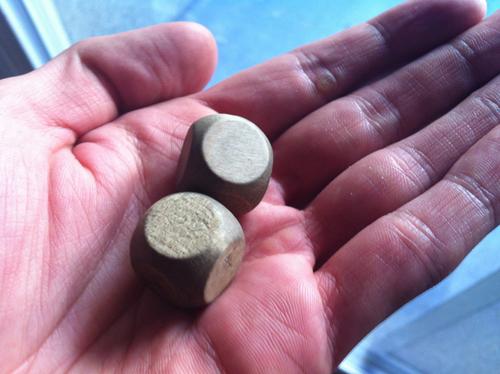
CoP is a secret organization that worships play. In contrast to other spiritual movements, members of CoP are highly skilled in reflecting upon their practice while enacting them. CoP also strongly encourages its members to constantly iterate on the design of their beliefs and practices. Our visual symbol is the black square, the first and last of all images. Our first symbol is a pair of blank dice, which are not only a symbol but also a tool around which many of our rituals emerge.
WHAT IS A REALITY GAME?
A reality game is a pervasive game that blurs the line between reality and fiction utilizing mass media conventions. In contrast to other pervasive games, reality games focus their design principles on the distinction between people who know and understand the rules of the game and people who do not. Think of an alternate reality game, but without the whole media manipulation aspect. All media assets generated by this young spiritual movement are real, and yet they are all part of a game. The game gives birth to a procedurally generated narrative, constantly reissuing the question on the correlation between fiction and reality to players and outsiders on many mediated layers.
The game is run by Negators, such as myself. We are capable of using our real name as our fictional identities in the game, since we are masters of play. We call ourselves “Negators” because our primarily function is to ensure the safely of our players and to make sure that the two rules of CoP are not being broken. We are also the ones that give Workshops and run Manifestations, which, in the current state of the game, are the two modules in which the game shows itself in the physical world. There are also Engineers in CoP, which are members that create and distribute the rituals of the organization, but who are less interested in running the metagame, but in designing and iterating on their own spiritual practices. They participate under pseudonyms in order to prevent themselves being discriminated.
WHAT IS A MANIFESTATION?
A Manifestation is a public ceremony of the rituals designed by Engineers. A Manifestation gives non-members a chance to try out our games, to get in direct dialog with the organization, and to experience first hand what we believe in. For the IndieCade Manifestation, I chose to work primarily with six volunteers, who would run and ultimately shape the Manifestation. These six volunteers would also contribute their own practice, all in the spirit of the game since it’s about existential and participatory game design. Every volunteer became a “Guardian of Play,” which involved them developing their own fictional identity, wearing a mask and having a specific role during the Manifestation.
The Manifestation had three phases: 1.) a recruitment phase of 45min, 2.) a public ceremony of roughly one hour, and 3.) a secret ritual guided by myself that was only accessible for players that showed themselves worthy in the eyes of play during the public ceremony. Between each public ritual the Guardians of Play would give a Golden Die to a participant who showed himself worthy in the eyes of play. This Golden Die granted the players access to the secret ritual rounding up the Manifestation. In this way, the Manifestation also reflected upon the dichotomy between the rituals we publish in our Codex, which are accessible to everybody, and the ones that only initiated members have access to, which occur only during initiations and by participating in the metagame. The Manifestation took place on Friday, the 4th of October during the “Beer Fest” of IndieCade.
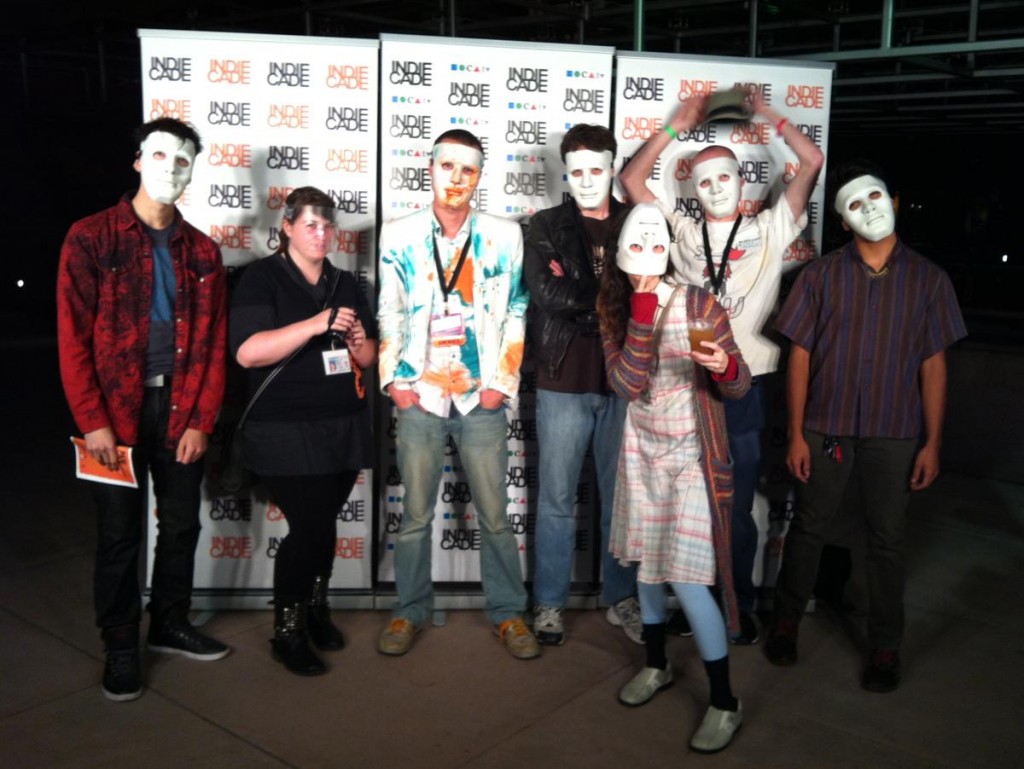
For the IndieCade Manifestation, we published the first iteration of our Codex of Play, a sacred publication that contains basic information about the reality game in its current state, a manifesto, and several easy instructions on how to connect with play. The Codex became the basic framework for the Manifestation and was published in a strictly limited edition of 213 pieces, making each of these a unique artifact. They were handed out during the Manifestation and came with a CoP sticker. During the recruitment phase, three Guardians of Play would missionize around the festival area, acting out their own fictional roles, playing with their blank dice, telling people about CoP, and handing out the Codex.
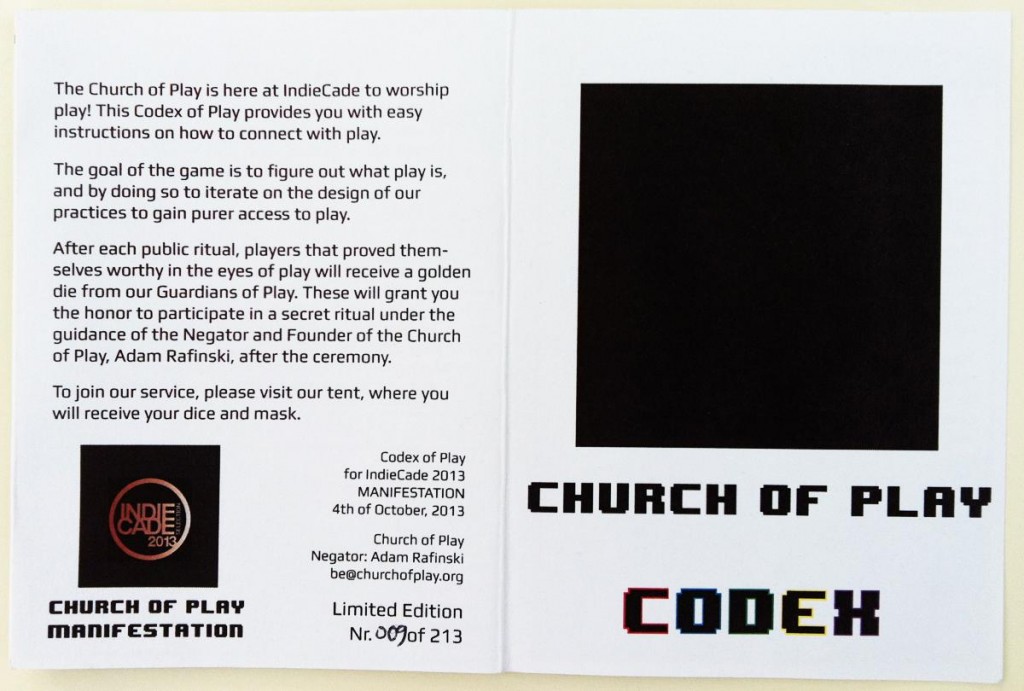
In order to join the public ceremony, interested players were instructed to come to our closed tent, which was ironically located between the Sony and Nintendo tent of the festival area. In front of the tent, potential players found two Guardians of Play that asked them the simple question, “Skull or Balloon?” If players choose skull, they had to throw a toy skull back and forth to each other. Whenever a player caught the skull so that it was facing the player, he was asked to give a quote from the Codex, such as “Play is Existence,” or “Games don’t need rules.” If the players chose the balloon, they were asked to bounce a balloon that was filled with a small amount of water on a fork between each other. There was no clear goal communicated to these exercises. If potential players were open to these absurd activities and executed them for some time in a playful way, they were granted access inside the tent.
Within the tent, players would find me in my Negator outfit, acting out my role. I gave them a little spiel on CoP, told them what’s going to happen during the Manifestation, and gave them all the prompts they needed in order to participate. First players picked a card with a symbol on it, but were not allowed to look at the symbol. This would become their new identity for the course of the ceremony. They were then told that the goal of the game is to figure out what play is. They were introduced to the two fundamental rules of CoP and that they are encouraged to iterate on the design of the rituals while participating in it. Finally they received their blank dice, which are required to play some of the rituals in the Codex. The indoctrination into the ceremony ended with me asking the players to put up a transparent mask, stand in front of a mirror, show their blank dice to the mirror and then me drawing their new symbol on the forehead of their transparent masks. Some of the rituals in the Codex require players to wear masks in order to distinguish themselves as participants instead of bystanders.
The ceremony began with the reading of a Manifesto. After the reading, all participating players were asked to spin in circles for as long as possible. The person last spinning decided which practice from the Codex would be executed first. After some rituals from the Codex were executed, players were asked to pick a Guardian of Play of their choice, which all had designed own practices, to execute these with them. At dusk the public ceremony ended, and I rounded out the Manifestation with a secret ritual within the tent to the players that received a Golden Die between the rituals and had thus earned this privilege. Unfortunately, the rules of the games forbid me to write about what happened, but people had a lot of fun even though it got a little more… messy.
I did not experience the public ceremony at all, since I was hiding all the time in the tent and preparing myself for the secret ceremony that ended the Manifestation. But thankfully one Guardian of Play took video materials of the whole event. People had a lot of fun and loved the rituals. I prepared prompts for 50 players, and after the recruitment phase we had only eight of them left. The video documentation shows that we turned IndieCade temporarily into a madhouse:
The IndieCade Manifestation was a huge success. People talked about our presence and the games we played. Some festival attendees even tweeted about it.
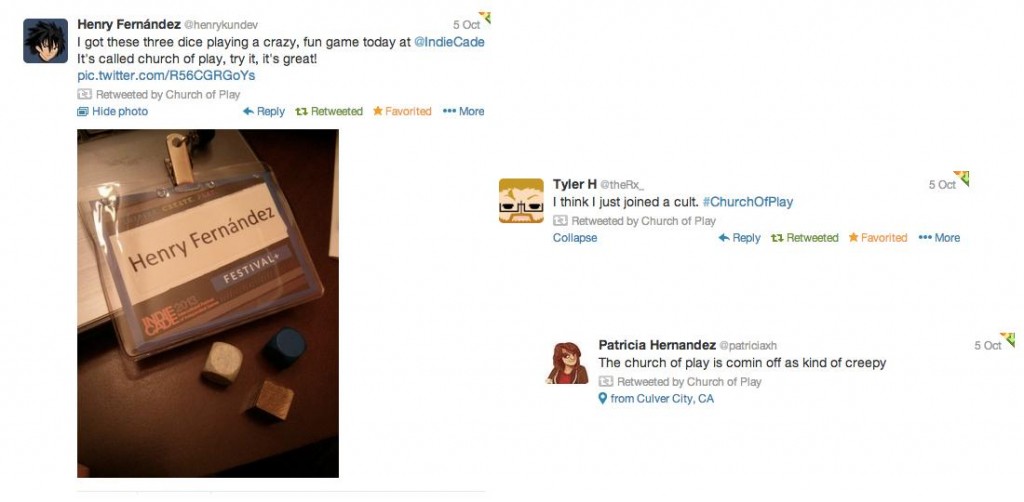
In addition, here are a few links to articles written about people’s CoP experiences:
- “Pixelated Performance Art, Or: How I Joined a Video Game Cult at IndieCade“
- “On Play“
- “Press Reset: Getting Physical at IndieCade“
- “IndieCade 2013“
After the IndieCade Manifestation, I stayed for one more week in Los Angeles to conduct two workshop series, one at UCLA and one at USC.
WHAT IS A WORKSHOP?
Workshops are another form in which the game shows itself in its current form. They are designed as games, involving some role-playing elements and simulating some core mechanics of the metagame at large such as secrecy. In LA they consisted of one public introduction and two closed sessions. Due to this rule, I am not allowed to talk about the details of the sessions here, but I can say that participants came up with really unique and intense new practices, and some of these might join the next iterations of our Codex. The dates were announced publicly, but with the exception of the open introduction, the locations of the sessions were a secret and only given to participants that made the decision to join the process after the introduction. Interested participants had to come to the introduction since here they received basic information about CoP, the rules and method of the game, as well as the structure of the workshop.
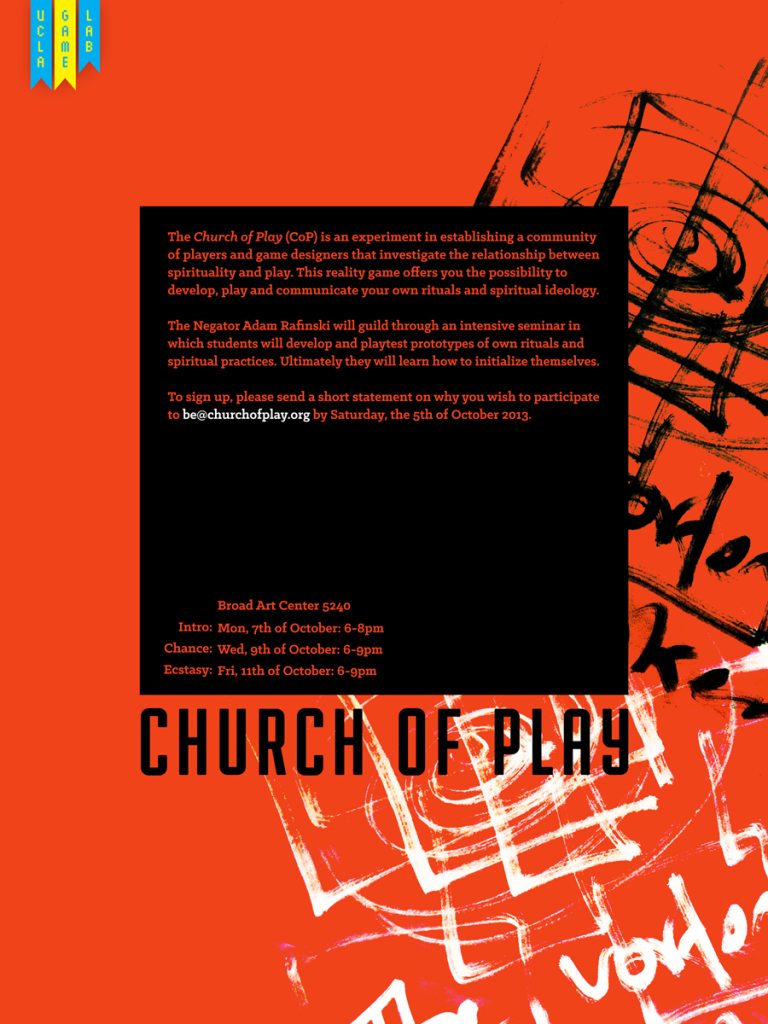
Both workshops at UCLA and USC were structured similarly, which gave me the opportunity to iterate also on the fly and to connect both groups in a playful way. The first session focused on Games of Chance and the second on Games of Ecstasy. In the Games of Chance session, participants were asked to come up with their own ritual that focused on randomness and to develop a narration or ideology that would symbolically express an overcoming of the players’ destiny by giving himself up to chance. In the Games of Ecstasy session, participants were asked to develop rituals that have a stronger immersive quality to it, encouraging physical activities and audio-visual stimuli. I have to say that I am very thankful that the ecstatic element, which was already a key mechanical approach of CoP rituals right from its very start last summer, truly found its form in Los Angeles.
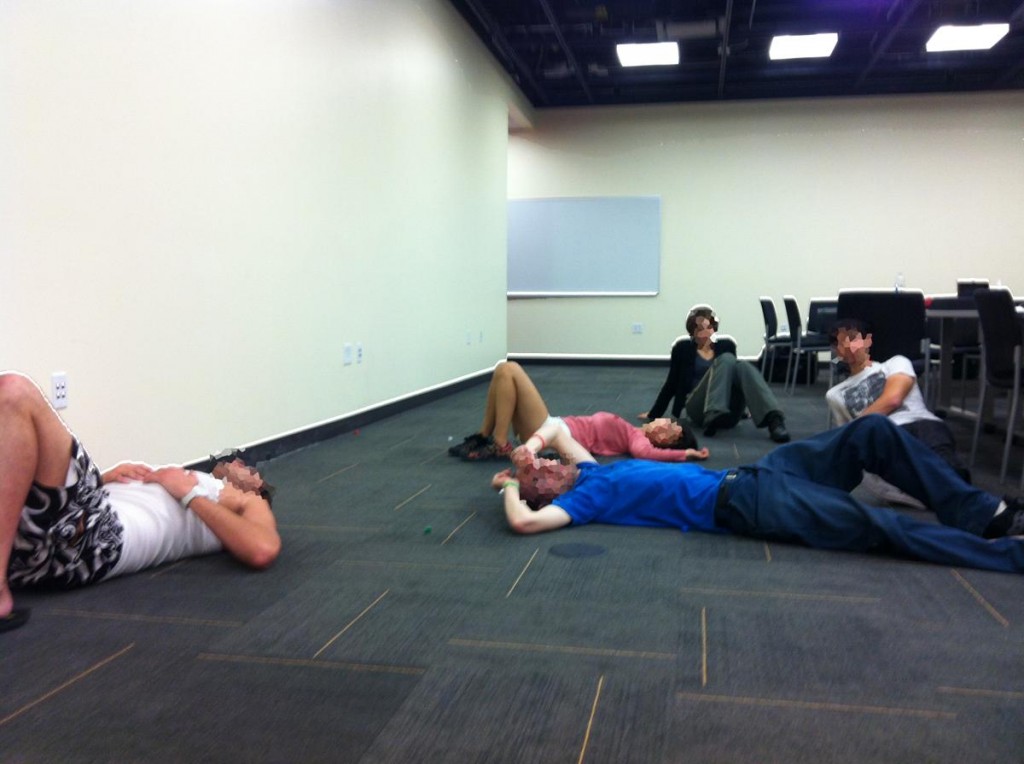
WHAT IS AN INITIATION?
After the workshops, players that contributed to our Codex by coming up with their own design were invited to make the decision of whether to join CoP or not and if they wanted to become Negators themselves. All Guardians of Play that contributed to our Codex, went through a similar process, and engaged workshop participants at UCLA and USC were invited to make this decision. The ones that made this decision designed together an initiation ritual, which happened on Tuesday, the 16th of October 2013 at a secret location in Los Angeles.
Unfortunately, the current version of the metagame makes it impossible for me to talk openly in this report about what exactly happened. If you wish to get access to the meaning of our practices and the initiations, you have to become a member of our community and participate in our metagame. But I can say that the initiation in Los Angeles was the most beautiful event I had the honor to experience so far. We had some really strong moments in which play was showing itself. I am very critical when it comes to art and aesthetic experiences, but I really have to say that some moments in this particular initiations blew my mind and overwhelmed me with a deep feeling of gratitude to know these wonderful people, from whom, as I suddenly realized, can learn a lot. I feel very grateful for meeting such fabulously talented game designers in Los Angeles and to welcome them as new companions in this journey of play. CoP is growing and I am confident that CoPLA (short for our new branch in Los Angeles) will certainly become an important and powerful part in the course of the game to come. Soon you will also be able to find more information about our practices online. The experience in Los Angeles gave us the legitimization to finally start publishing our Codex on a broader mediated scale, which we are working on currently.
I am very thankful for the support I received from The Ivan Allen College of Liberal Arts, the Digital Media program, and the GVU Center, without which my whole journey wouldn’t have been possible, and CoPLA wouldn’t have come into existence. I also like to thank all of the Digital Media students that gave feedback to a playtest session I conducted before the IndieCade Manifestation at the Experimental Game Lab and especially my committee, Celia Pearce, Carl DiSalvo and Ian Bogost, as well as Janet Murray and that one un-nameable individual in Digital Media for their critical advice and support, without which none of this would ever be possible. Now there is a CoP group in Los Angeles. Next I will focus on giving people in Atlanta the possibility to join this new, exciting global movement.

